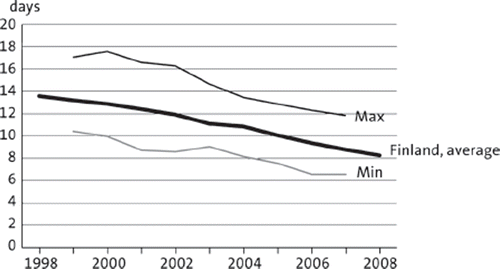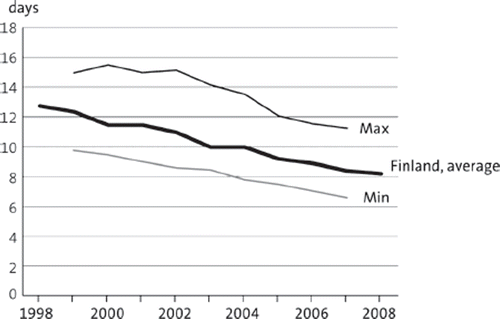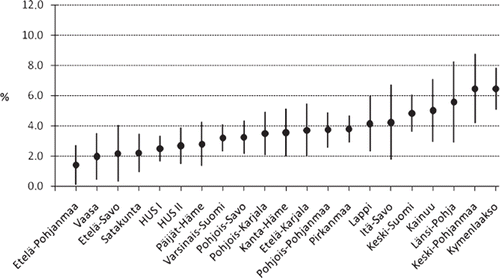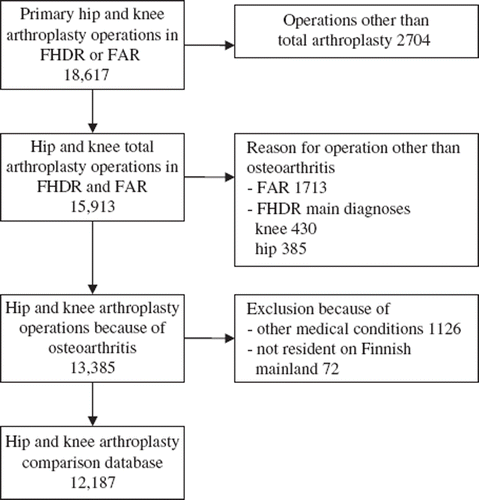Abstract
Introduction. This article in the supplement on the Performance, Effectiveness, and Costs of Treatment episodes (PERFECT)-project describes the PERFECT Hip and Knee Replacement Database and its possibilities by evaluating regional and hospital-level differences in length of stay (LOS), costs and complication rates of total hip arthroplasty (THA) and total knee arthroplasty (TKA) in Finland.
Material and methods. All hip and knee arthroplasties are recorded in the Finnish Hospital Discharge Register (FHDR) and Finnish Arthroplasty Register (FAR). LOS, length of uninterrupted institutional care (LUIC), complication rates and other parameters of treatment were determined by region and hospital during 1998–2008 based on these.
Results. LOS and LUIC following THA and TKA diminished during the follow-up period. In 1998 average LOS after THA and TKA was 9.9 and 10 days. In 2008, these had shortened to 5.2 and 5.3 days, respectively. There was a 5.0 and 7.5 percentage point difference in revision rate between regions in THAs and TKAs, respectively, performed during 2005–2007 and followed to the end of 2009.
Discussion. The Finnish health care registers provide a monitoring system for evaluating hospital- and regional-level differences in THA and TKA. The differences in LOS, LUIC and revision rates between hospitals and regions are considerable.
| Abbreviations | ||
| FAR | = | Finnish Arthroplasty Register |
| FHDR | = | Finnish Hospital Discharge Register |
| LOS | = | length of stay (in hospital's surgical department) |
| LUIC | = | length of uninterrupted institutional care |
| NCSP | = | Nordic Medico-Statistical Committee’ Classification of Surgical Procedures |
| OA | = | osteoarthritis |
| OR | = | odds ratio |
| PERFECT | = | Performance, Effectiveness, and Costs of Treatment episodes |
| THA | = | total hip arthroplasty |
| TKA | = | total knee arthroplasty |
Key message
Hospital discharge register and related registers provide a comprehensive monitoring system for evaluating hospital and regional-level differences in total hip arthroplasty and total knee arthroplasty.
Introduction
Total hip and total knee arthroplasty (THA, TKA) are the golden standards of treatment for severe osteoarthritis (OA) of the hip and knee refractory for conservative treatment. In Finland approximately 20,000 hip and knee arthroplasties are performed yearly and the trend has been increasing.
There are 20 hospital districts responsible for the management of hip and knee surgery in Finland. Hospital districts are financed by the municipalities. The annual number of hospitals performing THAs and TKAs has been around 60. There are 5 university hospitals, 20 central hospitals and almost 30 regional hospitals in Finland. A number of private hospitals perform arthroplasties as well (18 in 2007). In public hospitals patients are treated in line with their home municipality. The Ministry of Social Affairs and Health has recommended that arthroplasties should be performed in units where at least 200 replacements are performed annually. This recommendation has not yet been strictly followed. When there are many small hospital districts and operative units, regional and hospital-level differences in outcomes of THA and TKA may become significant. The importance of regular follow-up of these regional differences in terms of complication rates, length of surgical treatment period, unscheduled readmissions and costs is obvious.
This article in the Supplement issue on the Performance, Effectiveness, and Costs of Treatment episodes (PERFECT)-project aims to describe the Hip and Knee Replacement Database and its possibilities, by evaluating regional and hospital-level differences in length of stay, costs and complication rates of THA and TKA in Finland.
Material and methods
A comprehensive description of methods applied in the PERFECT-project is given in a separate article in this supplement (Citation1). As all hip and knee arthroplasty operations are performed in hospital inpatient wards, they are recorded in the Finnish Hospital Discharge Register (FHDR) (Citation2). Given that both hip and knee arthroplasty operations have distinctive operation codes in the Nordic Medico-Statistical Committee's Classification of Surgical Procedures (NCSP), which is in use in the FHDR, the total arthroplasty patient population was identified from the hospital discharge data by using a simple database query with a list of procedure codes. In addition, units performing arthroplasty are obliged to report their operations at patient level to the Finnish Arthroplasty Register (FAR). In this register additional information about the reason for operation, laterality, operational technique and implant type is provided (Citation3,Citation4).
In order to acquire the medical histories of the identified patients in the PERFECT hip and knee replacement comparison, data on all inpatient (1987–2009) and outpatient hospital care (1998–2009), primary and secondary arthroplasties (1982–2009), residential home care and care in service homes with 24-hour assistance (1997–2009), special reimbursements (1964–2009), prescription drug purchases (1994–2009), reimbursements of visits to private physicians (1998–2009) and deaths (1998–2009) for this population were obtained from the Finnish Hospital Discharge Register, the Finnish Arthroplasty Register, the Finnish Health and Social Welfare Care Register, the data warehouse of the Finnish Hospital Benchmarking Project, the reimbursement and prescription databases of the Social Insurance Institution, and the National Causes of Death Register using the unique national identification numbers of the patient population.
Inclusion and exclusion criteria
The patients were first identified using the classification of surgical procedures for hip (NFB30–NFB99) and knee (NGB10–NGB99). For example, in 2005 there were totally 15,913 admissions for 15,423 patients with primary total hip or knee arthroplasty as the first, second or third operation code in the Finnish Hospital Discharge Register (). Using personal identification numbers and information on admission and operation dates the records were matched with the arthroplasty register. Based on the reason for the operation in the arthroplasty register's record and the main diagnosis in the hospital discharge file for the operation, the population was restricted to include only operations performed because of primary osteoarthritis (main diagnosis: in hip M16.0, M16.1, M16.2, M16.3; in knee M17.0, M17.1). If a patient had a total hip and knee arthroplasty performed on the same hospital discharge, these operations were excluded from the comparison database (for example five cases in 2005). The main diagnoses on the patient's hospital discharges prior to arthroplasty surgery since 1987 were inspected and patients with a specific diagnosis given in inpatient care prior to the operation were excluded (a list of exclusion diagnoses is given as an ). In addition, patients not resident on the Finnish mainland were excluded from the final comparison database.
Appendix. Exclusion criteria: secondary diagnoses which lead to exclusion from the comparison database in THA and TKA.
The PERFECT hip and knee replacement comparison databases currently comprise the operations performed between 1998 and 2008, and will be updated for subsequent years as register data becomes available. The data is operation specific, except for same episode hip and knee cases. Following the same definitions and exclusion criteria as described above, there were a total of 107,392 operations in the comparison database for the years 1998–2008.
Definition of the treatment episodes
The surgical treatment period (index episode) is defined as the period when THA/TKA is performed on the hospital's surgical ward as recorded in the hospital discharge register. The surgical treatment period begins on admission to the surgical ward and ends either in discharge home, in transfer to another ward or facility, or in the death of the patient.
Uninterrupted institutional care (first hospital episode) is defined as the combination of the surgical treatment period and the health care periods immediately following. Uninterrupted institutional care ends either with the death of the patient or with discharge home, which includes those patients transferred to another facility such as old people's homes and institutions run by social welfare organizations. For calculations, the maximum length of institutional care was limited to 60 days. It was evaluated that after 60 days patients stayed in institutional care for a reason other than the performed arthroplasty.
Follow-up data for at least one year is available for each patient (if the patient did not die). The main observable events in the register data are admissions, operations and discharges as well as deaths. The secondary observable events are outpatient visits and medication purchases. Using the available data it is possible to reconstruct treatment pathways that describe what has occurred (before and) after the operation on a daily basis (Citation5).
Indicators of resource use and outcomes
There are several indicators calculated on the basis of the follow-up data in the PERFECT hip and knee arthroplasty project. These indicators are categorized as baseline, care and outcome indicators. Basic indicators are: the overall number of THA and TKA operations, the number of THA and TKA operations in the comparison database, the proportion of men among all patients, the mean age of the patients and the number of patients operated on in hospitals where more than 200 arthroplasties are performed annually. Indicators describing the care of patients are: the length of the surgical treatment period, the length of uninterrupted hospital care, type of surgery performed, and costs of treatment. The indicators reflecting the outcomes of care for THA patients are: revisions, dislocations and infections after surgery, the proportion of patients at home (7 or 14 days after admission), readmissions (outpatient visits or visits to a private physician within 14 and 42 days), and one-year mortality of patients.
Revisions were followed up to the end of 2009. A revision is considered here as either exchange or removal of the cup and/or stem or exchange of the head or liner. Supplementary tables in the PERFECT web pages describe annual trends and regional variation of some of these indicators.
Risk adjustment
In order to make justifiable comparisons between areas or in time, the indicators calculated for the subgroups of interest (hospitals, regions) are risk-adjusted using age, sex, previous contralateral arthroplasty of hip/knee and bilaterality of the operation, as well as the dichotomous variables derived from the previous use of hospital care (diagnosis codes) and use of drugs (prescription and special reimbursement data from the Social Insurance Institution) describing the existence of heart disease, hypertension, cancer, alcoholism, dementia, depression, Parkinson's disease, mental disorders, degenerative brain diseases or atherosclerosis (Citation1).
Results
The incidence per 100,000 inhabitants of primary THAs and primary TKAs for primary OA was 121 and 165, respectively, in 2008. There is considerable geographical variation in THA and TKA incidence rates. The relative differences between the highest and lowest incidence region is 2.2-fold to 1.6-fold.
length of stay (in hospital's surgical department) (LOS) and length of uninterrupted institutional care (LUIC) diminished steadily during the follow-up period in Finland. In 1998, LOS after THA and TKA were on average 9.9 and 10.0 days, respectively, whereas they were on average 5.2 and 5.3 days, respectively, in 2008 (supplement tables S38 and S45). In 1998, LUIC after THA and TKA were on average 13.6 and 13.1 days, respectively, whereas in 2008 they were on average 8.3 and 7.9 days, respectively ( and ). Differences in LOS and LUIC between regions and hospitals have remained throughout the study period.
Figure 2. Length of uninterrupted institutional stay in days on surgical ward for total hip arthroplasty in Finland between 1998 and 2008. Risk-adjusted numbers and hospital district extremes with three-year moving average. Min is the value for the district with the shortest length of uninterrupted institutional stay. Max is the value for the district with the longest length of uninterrupted institutional stay. The mean for the entire period is 10.8 days.

Figure 3. Length of uninterrupted institutional stay in days at surgical ward for total knee arthroplasty in Finland between 1998 and 2008. Risk-adjusted numbers and hospital district extremes with three-year moving average. Min is the value for the district with the shortest length of uninterrupted institutional stay. Max is the value for the district with the longest length of uninterrupted institutional stay. The mean for the entire period is 9.9 days.

There were remarkable differences in revision rates of THA and TKA between regions during the study period in Finland. In both operations the differences in reoperation rates of the lowest and highest rates were over 5 percentage points ( and ).
Figure 4. Proportion of revisions by hospital districts for operations in 2005–2007 for THA, risk-adjusted numbers and 95% CIs. The mean for the whole country for the period is 3.4%.

Figure 5. Proportion of revisions by hospital districts for operations in 2005–2007 for TKA, risk-adjusted numbers and 95% CIs. The mean for the whole country for the period is 3.2%.

As an example of the benchmarking information available data from 4 hospitals is presented (). In the example, in the hospital with the highest volume, there were 833 THAs performed during 2005–2007, whereas in the hospital with the lowest volume in our example there were only 166 THAs performed during the same period. LOS varied from 3.5 days to 10.8 days and LUIC from 6.0 days to 11.7 days. In readmission rates during 14 and 42 days there were 4.0 to 5.4 percentage point differences between hospitals during 2005–2007. In two of our hospitals, more than 70% of patients were at home one week after discharge, whereas in one of the hospitals none of the patients were at home within the same time. Revision, infection, dislocation and mortality rates as well as the costs of the surgical treatment period and uninterrupted institutional care varied between hospitals.
Table I. Risk-adjusted key indicators of total hip arthroplasty for four hospitals in 2005–2007. Hospital A is a central hospital, hospital B is a university central hospital, hospitals C and D are rural hospitals.
Discussion
The PERFECT hip and knee replacement comparison databases provide a comprehensive monitoring system for evaluating hospital- and regional-level differences in THA and TKA. There were considerable differences in LOS and LUIC, complication rates and costs between regions and hospitals in Finland.
The reasons for varying outcome and LOS of THA and TKA between regions and hospitals have been evaluated in several studies. However, we are not aware of any such study combining national arthroplasty register and discharge register data. It has been suggested that hospital volume is a good indicator of orthopaedic adverse events in patients undergoing THA surgery (Citation6). High mortality rates after THA and TKA have been associated with low hospital operative volume in several studies (Citation7–11). Lower provider volume has been associated with longer hospital stay after THA surgery (Citation11–13), and also with higher costs (Citation7, Citation13–15).
The studies using the PERFECT database confirm some of the earlier findings. As indicated earlier, LOS and LUIC diminished steadily from 1998 to 2008 and the differences in LOS and LUIC between hospitals and regions remained. The costs of hospitals with shorter LOS and LUIC were about 70%–80% of the costs of hospitals with longer treatment periods. It was found that high hospital volume has been strongly associated with shorter surgical treatment periods, and also with shorter uninterrupted institutional care (Citation13).
In addition, the rate of readmissions varied between regions and between hospitals in Finland. Moreover, it was found that short length of stay is associated with a high rate of readmissions after THA. When the length of stay is longer, early problems manifest in the hospital and are treated immediately in situ, thus readmissions are less likely to occur than in shorter stay facilities. However, the costs of increased readmission rates are low compared with the costs of longer length of stay (Citation13).
We found that revision rates between hospitals varied, and that the difference between hospitals with the most and fewest reoperations was statistically significant. However, the follow-up time in our study was relatively short, as the patients were followed up until the end of 2009. Revision rate during the first few years after primary THA consists of early and serious complications such as dislocation, component malpositions, deep infections and periprosthetic fractures. Revision rate might provide a good estimate of the quality of hip surgery in a hospital, at least when analyzing longer-term trends. Long-term survival results of producers are an important but slow parameter and thus not good for hospital management purposes. In PERFECT, at the moment we are able to provide ten-year follow-up results for the cohorts of 1998 and 1999.
Dislocation rate after THA is an important indicator of the quality of hip surgery. In Finnish hospitals it varied between 0% and 8.9% (hospitals’ three years averages of 2005–2007 with follow-up until the end of 2009). It has been stated that total hip replacements performed in high-volume hospitals may reduce dislocation rates (Citation13,Citation16). Dislocation problems may be more easily solved by a single clinic than the problem of deep prosthetic infections. Infection rate depends more on the whole health care system and, for instance, on the resistance of the bacteria against antibacterial drugs. In the current study, deep infection rate after THA varied from 0% to 3.8% (hospitals’ three years averages of 2005–2007 with follow-up until the end of 2009). Deep prosthetic infections after THA are nowadays rare and the capability of population-based studies to detect statistically significant differences between hospitals is limited.
The main aim of the PERFECT project is to produce information for individual hospitals and districts about their results and to stimulate local analysis and continuous work for improvement. It is not our aim to rank the hospitals according to treatment outcome. However, in addition to orthopaedic surgeons at individual hospitals, the data presented should be analyzed also by those responsible for managing and running orthopaedic surgery in Finland. The main strength of the current study is the access to a nationwide database with previously documented high data validity that allowed a population-based approach for this study. The reliability of the Discharge Register for reporting surgical operations is high. As early as the late 1980s at least 95% of operations were recorded in the Discharge Register (Citation1). It is also notable that the data for our studies also include all private hospitals. Thus these data are comprehensive. Furthermore, PERFECT data are adjusted for confounding factors by linking data of different registers with each other. In our view, this is highly important when comparing complication and mortality rates of different hospitals, such as rural and university hospitals. However, not all factors associated with complication rates, such as the surgical approach, can be adjusted. A limitation of register-based studies is the lack of clinical data.
The hospital discharge register and related registers provide a comprehensive monitoring system evaluating hospital- and regional-level differences in THA and TKA. In our opinion, it will provide guidance for managing hip surgery in Finland, and we hope that in the near future treatment recommendations could be given based on the current data.
Supplementary Tables S37–S50
Download PDF (464 KB)Acknowledgements
Other members of the Perfect group: are Heikki Kröger, Juhana Leppilahti, Miika Linna, Olavi Nelimarkka, Ilmo Parvinen, Seppo Seitsalo and Jarmo Vuorinen.
Declaration of interest: The authors report no conflicts of interest. The authors alone are responsible for the content and writing of the paper.
Funding/support: Research in the database has been supported by unrestricted grants from the Finnish Academy, the Finnish Innovation Fund SITRA and Helsinki University Central Hospital EVO funding.
Role of the sponsors: The funding sources for this study had no role in the design or conducting of the study; in the collection, management, analysis and interpretation of the data; or in the preparation, review or approval of the manuscript.
References
- Peltola M, Juntunen M, Häkkinen U, Rosenqvist G, Seppälä T, Sund R. A methodological approach for register-based evaluation of cost and outcomes in health care. Ann Med. 2011;43:S4–13.
- Keskimäki I, Aro S. Accuracy of data on diagnosis, procedures and accidents in the Finnish Hospital Discharge Register. Int J Health Sci. 1991;2:15–21.
- Paavolainen P, Hämäläinen M, Mustonen H, Slätis P. Registration of arthroplasties in Finland. A nationwide prospective project. Acta Orthop Scand Suppl. 1991;241: 27–30.
- Puolakka TJ, Pajamäki KJ, Halonen PJ, Pulkkinen PO, Paavolainen P, Nevalainen JK. The Finnish Arthroplasty Register: report of the hip register. Acta Orthop Scand. 2001a;72:433–41.
- Sund R. Utilisation of administrative registers using scientific knowledge discovery. Intelligent Data Analysis 2003; 7:501–19.
- Solomon DH, Losina E, Baron JA, Fossel AH, Guadagnoli E, Lingard EA . Contribution of hospital characteristics to the volume-outcome relationship: dislocation and infection following total hip replacement surgery. Arthritis Rheum. 2002; 46: 2436–44.
- Kreder HJ, Deyo RA, Koepsell T, Swiontkowski MF, Kreuter W. Relationship between the volume of total hip replacements performed by providers and the rates of postoperative complications in the state of Washington. J Bone Joint Surg Am. 1997; 79:485–94.
- Taylor HD, Dennis DA, Crane HS. Relationship between mortality rates and hospital patient volume for Medicare patients undergoing orthopaedic surgery of the hip, knee, spine and femur. J Arthroplasty 1997;12:235–42.
- Katz JN, Losina E, Barrett J, Phillips CB, Mahomed NN, Lew RA . Association between hospital and surgeon procedure volume and outcomes of total hip replacement in the United States medicare population. J Bone Joint Surg Am. 2001;83:1622–9.
- Katz JN, Barrett J, Mahomed NN, Baron JA, Wright RJ, Losina E. Association between hospital and surgeon procedure volume and the outcome of total knee replacement. J Bone Joint Surg Am. 2004;86:1909–16.
- Doro C, Dimick J, Wainess R, Upchurch G, Urquhart A. Hospital volume and inpatient mortality outcomes of total hip arthroplasty in the United States. J Arthroplasty 2006; 21(Suppl):10–6.
- Judge A, Chard J, Learmonth I, Dieppe P. The effects of surgical volumes and training centre status on outcomes following total hip replacement: analysis of the Hospital Episode Statistics for England. J Public Health 2006;28: 116–24.
- Mäkelä KT, Häkkinen U, Peltola M, Linna M, Kröger H, Remes V. The effect of hospital volume on length of stay, re-admissions and complications of total hip arthroplasty – a population-based register analysis of 72 hospitals and 30,266 replacements. Acta Orthop 2011; 82(1):20–6.
- Martineau P, Filion KB, Huk OL, Zukor DJ, Eisenberg MJ, Antoniou J. Primary hip arthroplasty costs are greater in low-volume than in high-volume Canadian hospitals. Clin Orthop Relat Res. 2005;437:152–6.
- Mitsuyasu S, Hagihara A, Horiguchi H, Nobumoto K. Relationship between total arthroplasty case volume and patient outcome in an acute care payment system in Japan. J Arthtoplasty 2006;21:656–63.
- Shervin N, Rubash HE, Katz JN. Orthopaedic procedure volume and patient outcomes: a systematic literature review. Clin Orthop Relat Res 2007;457:35–41.

